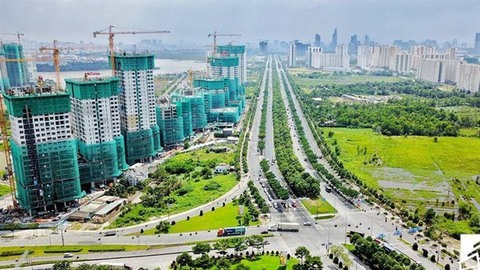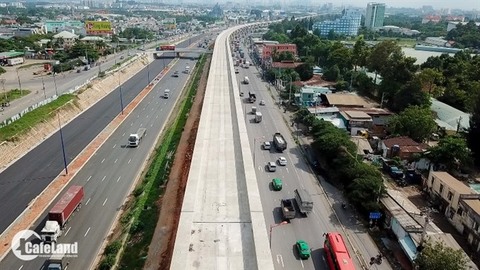Generating sustainable urban centres to help curb emissions
Generating sustainable urban centres to help curb emissions
Vietnam is undergoing attempts to reduce the emission of greenhouse gases in urban areas. Adam Ward, the representative for Vietnam at the Global Green Growth Institute, gives an insight on how the nation can accomplish this mission and create greener urban areas.
Vietnam’s Nationally Determined Contribution (NDC) was issued in November 2015 as a commitment to reduce greenhouse gas (GHG) emissions, contributing to limiting global warming to less than two degrees Celsius by the end of the century.
Vietnam’s NDC emission reduction target is set at 8 per cent with business-as-usual conditions (unconditional contribution) compared to 25 per cent with international support (conditional contribution). To be able to achieve these targets, in October 2016 Vietnam issued the Plan for Implementation of the Paris Agreement which lays out the steps it will take in order to reach the emission reduction target.
Cities are major contributors to GHG emissions. The International Energy Agency estimates that urban areas currently account for over 67 per cent of energy-related global GHG, which is expected to rise to 74 per cent by 2030. It is estimated that 89 per cent of the increase in carbon dioxide (CO2) from energy use will come from developing countries.
Improved urban designs and mobility are crucial to reducing emission. Urbanisation alone does not increase emissions, but rather how people move about the city, the sprawl of the cities, and how people use energy within urban areas. These factors are what make the difference in how cities pollute and contribute to climate change.
There is also a strong correlation between GHG emissions and municipal solid waste. Rapid urbanisation, coupled with population growth, has led to an increase of municipal solid waste generation by 10 per cent annually.
Over 80 per cent of municipal solid waste collected is buried in unregulated dumps. Cities are also large consumers of energy, in 2035 energy demand will be over twice as high as it was in 2015. The energy and waste sectors represent 52 and 7 per cent of the national GHG emissions, respectively.
Difficulties remain
Vietnam is facing a number of challenges in achieving NDC targets. All mitigation options require a high level of investment, along with the costs of infrastructure and mitigation technologies. The funding needed to implement the mitigation options and achieve the emission reduction targets is $1.89 million.
Nationwide, municipal solid waste with a high organic content (52-77 per cent), largely from food waste, releases a large amount of methane. This high organic waste content results in the disposal of municipal solid waste in landfills, primarily open dumps, or through composting. Rural areas also practice open burning to manage waste. Approximately 8-15 per cent of municipal solid waste (for example paper, plastic, and metal) is recycled.
However, recycling businesses mainly use obsolete technologies which can result in severe environmental pollution.
Although a significant number of policies and regulations exist on solid waste, there is not a legal system for enforcement present in cities and provinces. The challenges of co-ordinating between different agencies often results in a communication breakdown between national, provincial and city governments.
Within urban areas, households and businesses have the fastest growing demand for energy. The combined electricity consumption of the administration and household sector, along with the service and commercial sector accounted for about 43 per cent of total annual electricity consumption or about 45,000 gigawatt-hour (Gwh). This corresponds to 25.7 million tonnes of CO2 emissions. Commercial services and household appliances are projected to be the fastest growing sector in terms of end use energy demand.
The Initial Biennial Update Report projects the transport sector’s energy consumption will rise from 14.4 million tonnes of oil equivalent (MTOE) in 2015 to 19.5 and 31.8 MTOE in 2020 and 2030 respectively, implying an average annual growth rate of 5.4 per cent.
Many Vietnamese cities have set targets for public transport to increase its modal share to 25-45 per cent in the 2020-2030 period, whereas currently few have higher than 10 per cent, although this is gradually increasing.
Renewable energy and efficiency projects require high levels of investment in infrastructure, long-term financial planning and sufficient resources to secure continuous operation and maintenance.
However, such projects are generally treated as regular financing with short term loan periods. Suitable and effective financial mechanisms along with fiscal products, for instance tax incentives, to support renewable energy and building designs with energy efficiency are not yet available in Vietnam.
Therefore, these projects receive low levels of incentives from the private sector.
Conclusions to draw
As stated above, cities contribute the majority of total GHG emissions and no reduction will occur without major changes. The national government should ensure NDC implementation that cuts across all levels of governance, especially at provincial and city levels.
The Vietnamese government should also work in close partnership with sub-national governments, providing frameworks for GHG reduction and maintaining funding to be consistent with the challenges they face.
Now is the time to engage local and regional governments in delivering national commitments and raise ambitions globally.
City governments each have a unique set of capabilities and political opportunities to reduce emissions. Reducing GHG emissions requires individuals and organisations to make new choices about how they invest, what they buy, how they behave, and what they build.
It is not just what city governments do, but also how they do it that matters.
Reducing GHG emissions in cities in Vietnam is a complex endeavour. Two very different sectors contribute the majority of urban GHG emissions: energy use in buildings and transportation, which is a function of both energy sources and energy demand; and waste management.
The relative contribution of each sector can vary significantly between cities, whilst the investments and actions needed for GHG reductions vary significantly between sectors. For example, reducing GHG emissions from transportation systems requires public and private capital investment into public transit. In contrast, reducing GHG emissions from energy use in buildings requires thousands of building owners to install energy- efficient appliances.
Due to the impact of climate change, provincial and city governments have rightly placed a priority on adaptation. Actions to adapt urban areas to climate change also have had positive mitigation impacts, and vice-versa, providing a win-win for cities.
Actions that provide both adaptation and mitigation benefits should be prioritised by cities and opportunities exist for cities to access climate finance to both invest on low-carbon solutions as well as to increase climate resilience.
Mitigation measures in the waste and energy sectors not only target reductions in GHG emission but are also driven by their strong environmental, social, and sustainable development benefits.
Given that over 50 per cent of the nation’s citizens will live in cities by 2030, Vietnam cannot achieve the UN Sustainable Development Goals and the Paris Agreement without implementing the recommendations.
City leaders across the country must have the drive to create sustainable urban centres for future generations. Given the right backing, environmental targets in the NDC can be achieved and even exceeded.








